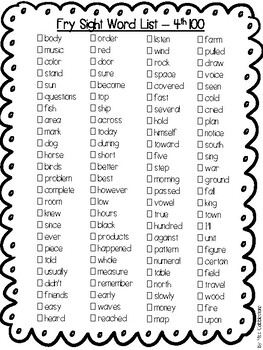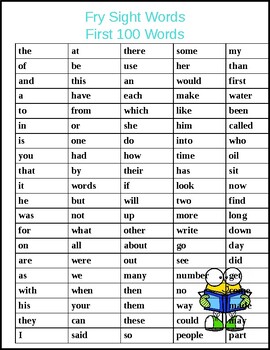

…when phonics instruction is introduced after students have already acquired some reading skill, it may be more difficult to step in and influence how they read, because it requires changing students' habits. Linnea Ehri in Systematic Phonics Instruction: Findings of the National Reading Panel talks about this problem as well:

Many remedial students have developed guessing habits from too many sight words. Also, Don Potter has an excellent sight word web page explaining the harm that sight words can do. More videos are in aYouTube sight word playlist.

#FRY 800 100 SIGHT WORDS ALPHABETICAL ORDER MOVIE#
To learn more about sight words, you can watch the sight word movie in QuickTime format or in YouTube format. įor further explanation of how sight words can encourage the symptoms of dyslexia and an explanation of the nature of sound and how our brains learn to process the sounds in words, see the dyslexia page. Sounding every word out from left to right helps encourage proper left to right eye movement while reading. Too many words taught as wholes by sight encourages the symptoms of dyslexia. Recent brain research has found that the adult brain of good readers does not process words as wholes, but instead, as Stanislas Dehaene explains in his article, The Massive Impact of Literacy on the Brain, by analyzing the individual letters and letter teams at the same time in a "massively parallel architecture." The speed of this parallel processing led early researchers to believe that the brain was processing the words as a whole, but recent brain research using more powerful technology has found the opposite. For a good explanation of the nature and history of these sight words lists, see Comparing the Dolch and Fry High Frequency Word Lists by Readsters. They should merely be taught phonetically along with other words.īoth the Fry and Dolch sight word lists are based on whole word methods and are high frequency words. Sight words should not be taught at all in a pure phonics program that teaches by sound. Of these 12 Fry sight words, 9 are completely phonetic and the other 3 have simple exceptions. The Fry 100 sight words or "instant words" are also commonly taught, and all but 12 of them are contained on the Dolch list. For the other 70 words, 68 conform to simple patterns of exceptions and can be taught phonetically. Of the 220 most commonly taught Dolch sight words, 150 are completely phonetic and can be easily learned by sound. However, many of the newer phonics programs also use an alarming number of sight words.

This can cause problems for many students. This research, based upon the most current data, was distilled, calibrated and analysed to produce the Magic Words word list, which is believed to be the best collection of high-frequency words available.Whole word methods teach every word as a sight word, one word at a time, without teaching students the sounds in these words. Magic Words undertook a meta-analysis of research into high-frequency words to determine the highest value set of words possible and has resulted in a new edition. Magic 100 Words are the 100 most important words in learning to read and write. 12 Blue Words, 16 Green Words, 16 Orange Words, 12 Indigo Words and 12 Violet Words (68 words) together with the 12 Golden Words and the 20 Red Words make up Magic 100 Words®.20 Red Words, together with the 12 Golden Words (32 words), make up one-third.Magic 100 Words are divided into seven levels which make up, on average, half of all words used in reading and writing. This unique compilation of words has been divided into statistically significant collections presented as coloured levels These best-selling Magic Words cards are ideal for playing at home and school to learn the most important words in reading and writing. Magic 100 Words make up half of all the words in reading and writing. Magic Words are the most common words in English and are the most important words in learning to read and write.


 0 kommentar(er)
0 kommentar(er)
